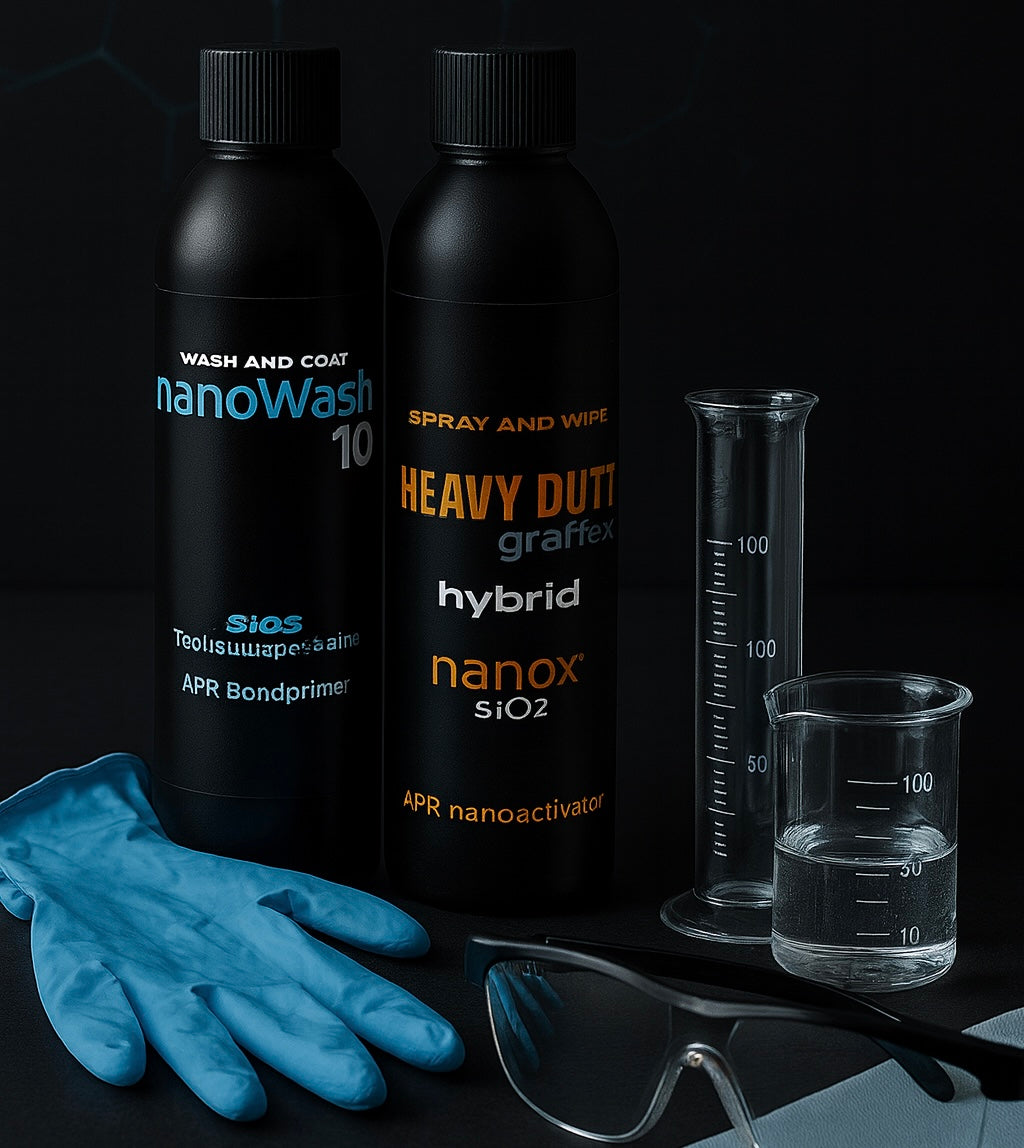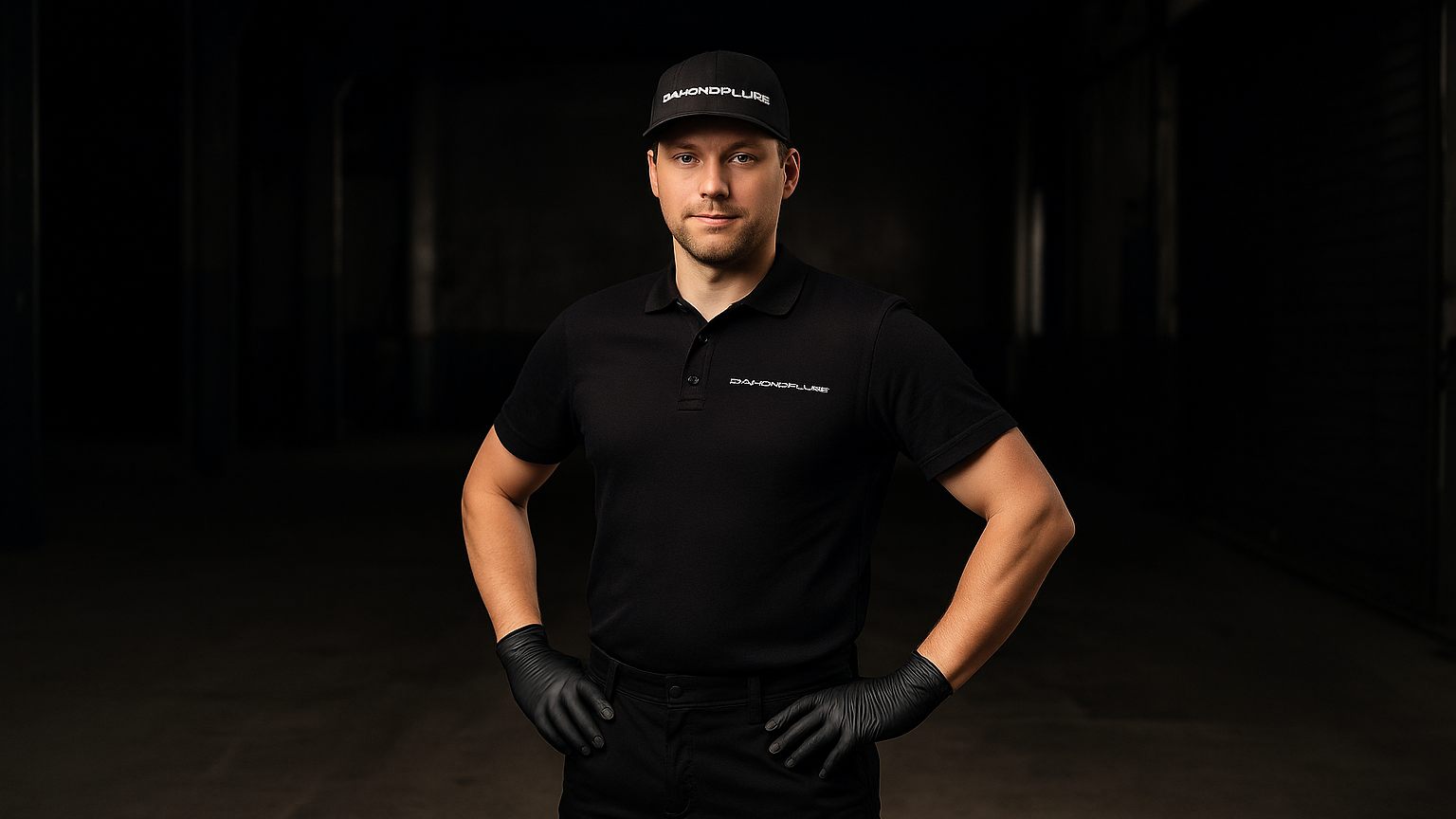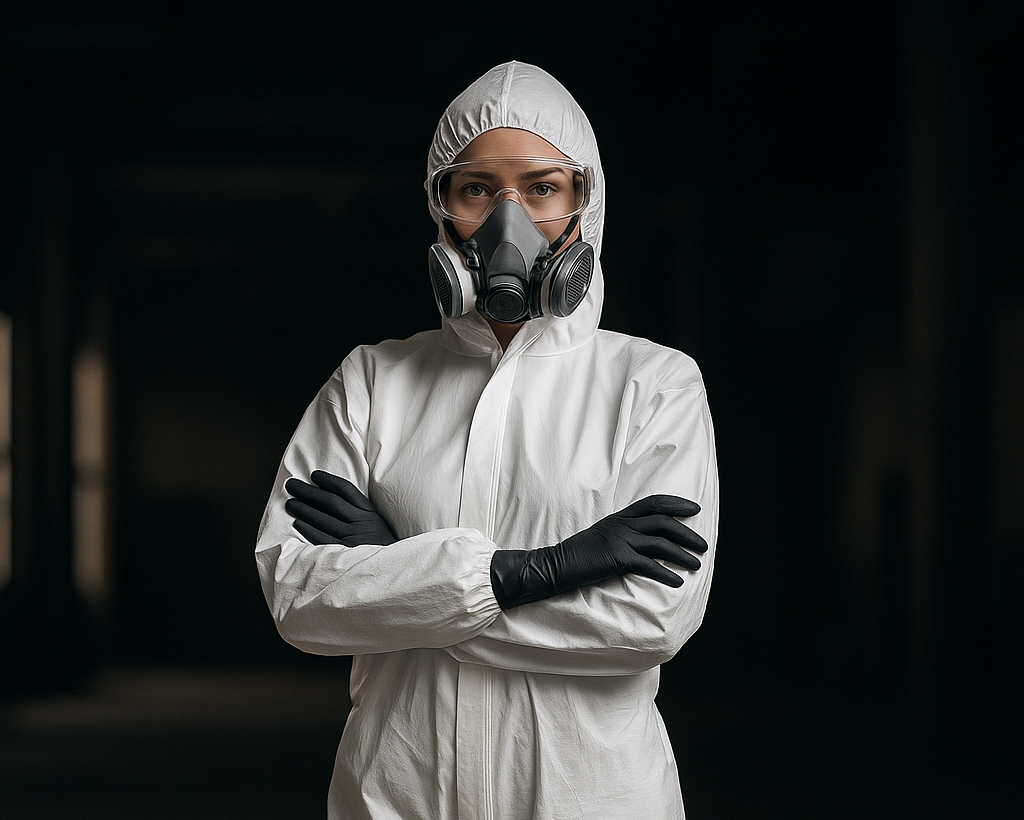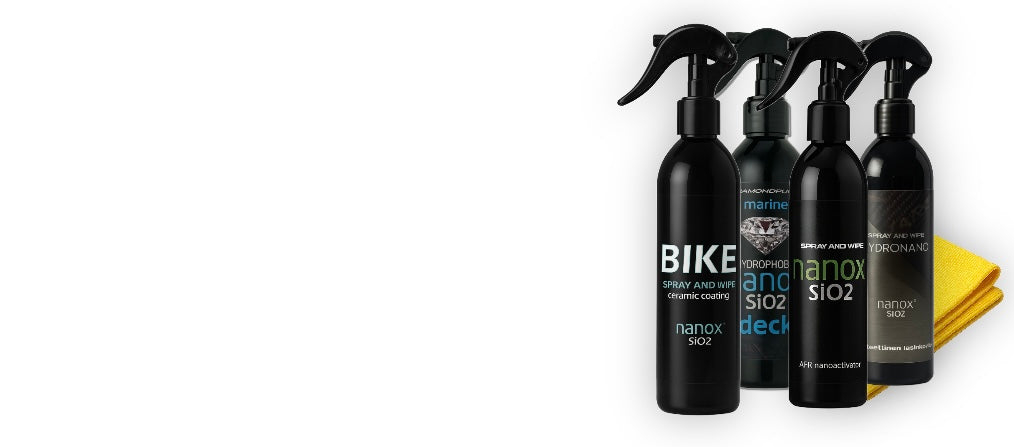
Safe use of products and instructions for use.
Why protective equipment? Why instructions for use? Because chemistry of this level does not negotiate.
Protective equipment is not a recommendation – it is a requirement.
Diamondplure products are based on ultra-fine SiO₂ technology and advanced coating solutions. Some products, such as powerful reactive detergents, use active compounds that break down dirt and mineral deposits quickly and effectively.
Fine mist and microdroplets can be generated during use, which must be managed properly — that is why protective equipment is an important part of both the quality of work and the well-being of the user.

Product safety
- Why are the primer and activator delivered in separate packages?
- Why combining them is risky for storage and security
- Why can ceramic coating be packaged in a plastic bottle?
APR primer and nanoactivator are designed to work synergistically only at the time of use. We keep them in separate packages to avoid premature polymerization and uncontrolled reactivity, ensuring both user safety and complete bonding performance in the coating.
The ceramic SiO₂ dispersion is stabilized in plastic-compatible carrier solvents, allowing it to be safely packaged in a high-quality HDPE or PET bottle without chemical interaction.
Everything is controlled security.


What kind of protective equipment is recommended when using Diamondplure products?
Are protective gloves and goggles enough?
The right protective equipment – safe work, perfect results - Satisfied customer and owner
Diamondplure products are based on advanced SiO₂ and APR technology, and some products contain highly reactive ingredients.
Using the right protective equipment is not a recommendation – it is part of the safety obligations and ensures both safe working and a perfect end result.
Basic protection for light washing and coating
For example nanowash™ ION and SPEED, HYDRONANO, nanox marine deck, nanox bike.
- Lightweight P2 respirator – protects against fine droplets and dust (recommended)
- Lightweight safety glasses – prevent splashes in the eyes (recommended)
- Latex or nitrile gloves – protect skin from mild detergents and coatings
- Long-sleeved clothing or a light protective shirt – prevents skin contact (detergents) (recommended)
- Good ventilation – ensures comfortable working conditions
Full protection for heavy washes and coatings
For example, graffex jybrid, HEAVY DUTY, infrax, Solution Wash, bathroom cleaning and coating.
- P3 respirator – protects against fine aerosols and strong chemical vapors
- Splash-proof goggles or a full face shield – prevent chemicals from getting into your eyes
- Thick nitrile gloves – resistant to acids, solvents and reactive compounds
- Long-sleeved protective clothing or disposable coveralls – prevents skin contact with strong chemicals
- Local exhaust ventilation or well-ventilated work area – minimize exposure
- Lockable storage case for used equipment – ensures safety even after work
Because we are interested in your safety.

nanowash - Instructions for use
Follow the instructions – the result is what matters. Correct dosage + correct application = perfect surface and long-lasting protection.
Collapsible content
nanowash™ - Instructions for use of detergents
The Diamondplure™ manowash™ range is designed for professionals and demanding users who want to maximize coating performance and surface cleanliness. The products are formulated with advanced SiO₂ and APR technology, combining cleaning, priming and coating maintenance in one step.
1. Preparation before washing
- We always recommend a cool, shaded surface.
- Rinse loose dirt with water first.
- Choose the right nanowash™ product based on the surface material and application.
Nanowash™ – Dilution Instructions
nanowash™ SPEED – Maintenance wash and coating boost
- Dilution: 1:50
- 4 capfuls / 1 liter of water
- 7 caps / 1 liter of shampoo for lathering
- Do not use undiluted
- Dilute the concentrate 1:10 for aluminum, greasy/dirty surfaces.
- Provides a clean surface and leaves a covalent SiO₂ protection.
nanowash™ ION – Maintenance wash and coating boost
- Dilution: 1:100
- 6 caps / 1 liter of shampoo for lathering
- Do not use undiluted
- Dilute the concentrate 1:10 for aluminum, greasy/dirty surfaces.
- Provides a clean surface and leaves a covalent SiO₂ protection
nanowash™ 10 – Normal wash and coating boost
- Dilution: 1:400
- 1 capful / 2 liters of water
- 5 caps / 1 liter of shampoo for lathering
- Do not use undiluted
- Dilute the concentrate 1:10 for aluminum, greasy/dirty surfaces.
- Washing power adjustable between 1/10 - 1/400. (pure metals, e.g. aluminum 1/10)
Provides a clean surface and leaves a covalent SiO₂ protection.
nanowash™ Snow foam – Normal wash and coating boost
- Dilution: 1:5 foaming bottle
- 1/1 for pressure washer foam, dilute if desired.
Provides a clean surface and leaves a covalent SiO₂ protection.
2. Washing and rinsing
- Choose the right Nänanowash™ product according to the surface and need:
- ION – Maintenance wash and coating reinforcement
- SPEED – Fast, impressive shine and extra protection for bicycles and electric vehicles
- 10 – Deep cleaning, industrial level
- Snow Foam – Foam wash for fast and impressive cleaning of all surfaces
- Prepare the washing solution in the correct dilution ratio in the washing container.
Follow product-specific instructions carefully to achieve the best protection and cleaning performance. - First rinse the surface with water to remove loose dirt.
Always work in the shade and on a cool surface. - Apply the detergent evenly with a wash mitt, sponge or foam applicator.
Always wash one panel at a time, from top to bottom, to prevent dirt from spreading. - Leave on for 1–2 minutes, but do not let the detergent dry on the surface.
- Rinse the surface thoroughly with plenty of water.
This step is important because nanowash™ products utilize controlled hydrolysis:
- Abundant rinsing stops the chemical reaction at the right stage
- Ensures that no residue or streaks are left on the surface
- Leaves the surface neutral, allowing the SiO₂ and APR protection to be fully activated upon drying
6. Dry the surface with a microfiber cloth or drying towel. Do not use a spatula or compressed air, as they do not activate the SiO₂ and APR technologies in the same way.
During drying, fusion occurs, giving the surface maximum gloss, repellency and durability.

The professor explains… The importance of drying and the correct technique
During drying, the final and most critical step occurs, where the SiO₂ and APR technology contained in nanowash™ products fuse with the surface. This chemical process requires that microscopic detergent and water residues are mechanically wiped away, not simply drained.
Why a microfiber cloth or drying towel is essential
- Microscopic friction activates fusion → Light wiping causes SiO₂ particles to migrate into the pores of the surface structure and form a uniform, repellent protective film.
- A silicone spatula or compressed air is not enough → They remove the water but do not touch the surface; in this case, the SiO₂ and APR polymers do not bond completely.
- Neglecting to dry = less shine → The surface remains “passive” and repellency, shine and durability can be significantly weaker.
- Microfiber cloth construction → Diamondplure™ Micro400 or similar cloth is designed to collect moisture and the last traces of solvent, leaving the surface completely neutral.
In brief:
Lightly wiping the surface is not just drying — it is part of the activation of the protective layer.
If you use just a spatula or compressed air, the protective film will not fuse completely and the surface will not be as shiny or repellent.

nanox® - Instructions for use of fast SPRAY AND WIPE coatings
Follow the instructions – the result is what matters. Correct dosage + correct application = perfect surface and long-lasting protection.
Collapsible content
nanox®- SPRAY AND WIPE instructions for use
nanox SiO₂ coatings are based on ceramic hybrid technology, where APR bondprimer and nanoactive SiO₂ form a fused, durable protective layer. The correct working method is crucial to achieve perfect adhesion, gloss and repellency.
Spray and wipe the coating (SPRAY AND WIPE), immediate reaction and the surface is immediately ready.
- Spray the coating lightly directly onto a clean, dry surface (contamination). Spray 2 sprays onto a cloth before placing a dry cloth on the surface.
- Go through all surfaces in one work step.
- Work in small areas (50×50 cm) to prevent the coating from drying out before wiping.
- Wipe the contaminated surface with a microfiber cloth to allow the SiO₂ bondprimer to settle on the surface → this activates the fusion.
- Work quickly because the fusion takes about 3 seconds.
- Repeat the treatment on surfaces as needed. For example, it is a good idea to treat the sides and rear of the vehicle twice due to the harsh winter conditions.
Professional tips
- Always wash and prime the surface with nanowash™ → maximize adhesion and protection.
- When spraying, use the finest mist possible (e.g. Diamondplure™ SPRAY AND WIPE nozzle).
- Do not handle surfaces that are too hot or work in direct sunlight.
- Keep the coating application area clean and dust-free throughout the process.
During drying, fusion occurs, giving the surface maximum gloss, repellency and durability.

graffex - Instructions for use of spray-applied coatings
Follow the instructions – the result is what matters. Correct dosage + correct application = perfect surface and long-lasting protection.
Collapsible content
graffex - Instructions for use of spray-applied graphene coatings
graffex™ coatings are high-performance SiO₂/graphene hybrid coatings that utilize APR primer + nanoactive graphene technology.
The correct application method and control of the coating are crucial to achieve maximum gloss, durability and dirt-repellent protection.
Areas of application of the coating:
The graffex™ series includes different products for different needs:
- graffex Hybrid → vehicles, high gloss, lasts up to 36 months
- graffex HEAVY DUTY → heavy equipment, high chemical resistance, lasts up to 12 months
- marine race → boat hulls, bottoms and engines, duration from up to 6 months
Priming the coating, working and polishing the paint surface.
Diamondplure™ coatings form a permanent covalent Si–O–Si bond only on a clean and active paint surface.
If the surface has been polished with pastes other than 3M's Perfect-It series, there will certainly be silicone, wax or polymer residues on the surface, which will inhibit the APR reaction and reduce the adhesion of the coating by up to 90%.
Do this before coating:
- Wipe the surface to be treated thoroughly with an IPA-based cleaner (≥70%).
- Then wash with nanowash™ 10 (1:400) and rinse the surface thoroughly.
- Make sure the surface is completely dry and clean of all paste residue before applying the coating.
Only 3M Perfect-It series pastes are compatible with Diamondplure coatings and do not require separate IPA cleaning.
Spray coating (SPRAY COATING)
- Mix the coating before use.
Shake vigorously for 1 minute to mix the chemicals evenly.
- Adjust the sprayer to produce a fine, even mist.
Nozzle: 0.8–1.2 mm → pressure: 1.8–2.0 bar. Spray the coating evenly from a distance of approximately 40–50 cm.
Treat a maximum of 2m2 of area at a time. Wipe the surface until shiny with a microfiber cloth, for example a Micro400 cloth . - Once all surfaces have been coated, let the coating set for 10 minutes and repeat the spraying → The coating is sprayed onto the surfaces 3 times .
Wipe the coated surface lightly with a microfiber cloth using a crisscross technique until the surface is completely clear and streak-free.

The professor explains… Formation of SiO₂ and graphene layers
In graffex™ coatings, a two-step hybrid process occurs, in which SiO₂ and graphene do not mix, but form separate structures that work synergistically:
Step 1. Formation of SiO₂ fusion
- When graffex™ is applied to the surface, the APR bondprimer is activated.
- APR directs the covalent bonding of the SiO₂ network directly to the functional groups of the surface material.
- The result is a chemically fused SiO₂-based ceramic substructure that acts as a “base mesh”.
This layer is:
- Hard (9H grade)
- Transparent
- Tightly connected to the surface
Step 2. Graphene crosslinking
- Graphene particles do not react chemically with SiO₂ → they remain separate.
- During drying and wiping, graphene arranges itself on the surface, forming a thin, highly durable carbon network.
Graphene is:
- Mechanically flexible
- Extremely chemical and heat resistant
- Electrostatically active → helps with dirt-repellent effect
The end result is a two-layer protection:
- Bottom layer: SiO₂ fusion layer chemically bonded to the surface
- Top layer: graphene mesh that enhances the surface's wear resistance and dirt-repellent properties
Fusion “bond” between graphene and SiO₂
Graphene does not form an actual chemical bond to the SiO₂ layer, but its stability is based on two factors:
- The surface tension of the APR primer → controls the deposition of graphene onto the SiO₂ network during drying. (That is why nanowash and rinsing are important)
- Van der Waals interactions and the electrostatic affinity of graphene → hold the graphene network tightly to the surface of the SiO₂ substrate.
In practice, this means that the SiO₂ fusion “locks” the surface and the graphene forms a separate, highly durable “top coat” network on top of it.
Briefly and clearly:
Note: in graffex™ coatings, SiO₂ and graphene do not mix, but form two layers:
- SiO₂ fusion chemically bonds to the surface → hard, transparent substructure
- Graphene networks as a separate surface layer → flexible, chemical and dirt-repellent protective network
The end result is a synergistic hybrid surface that combines the durability of SiO₂ and the superhydrophobic properties of graphene.

Perfect… It's chemistry.

